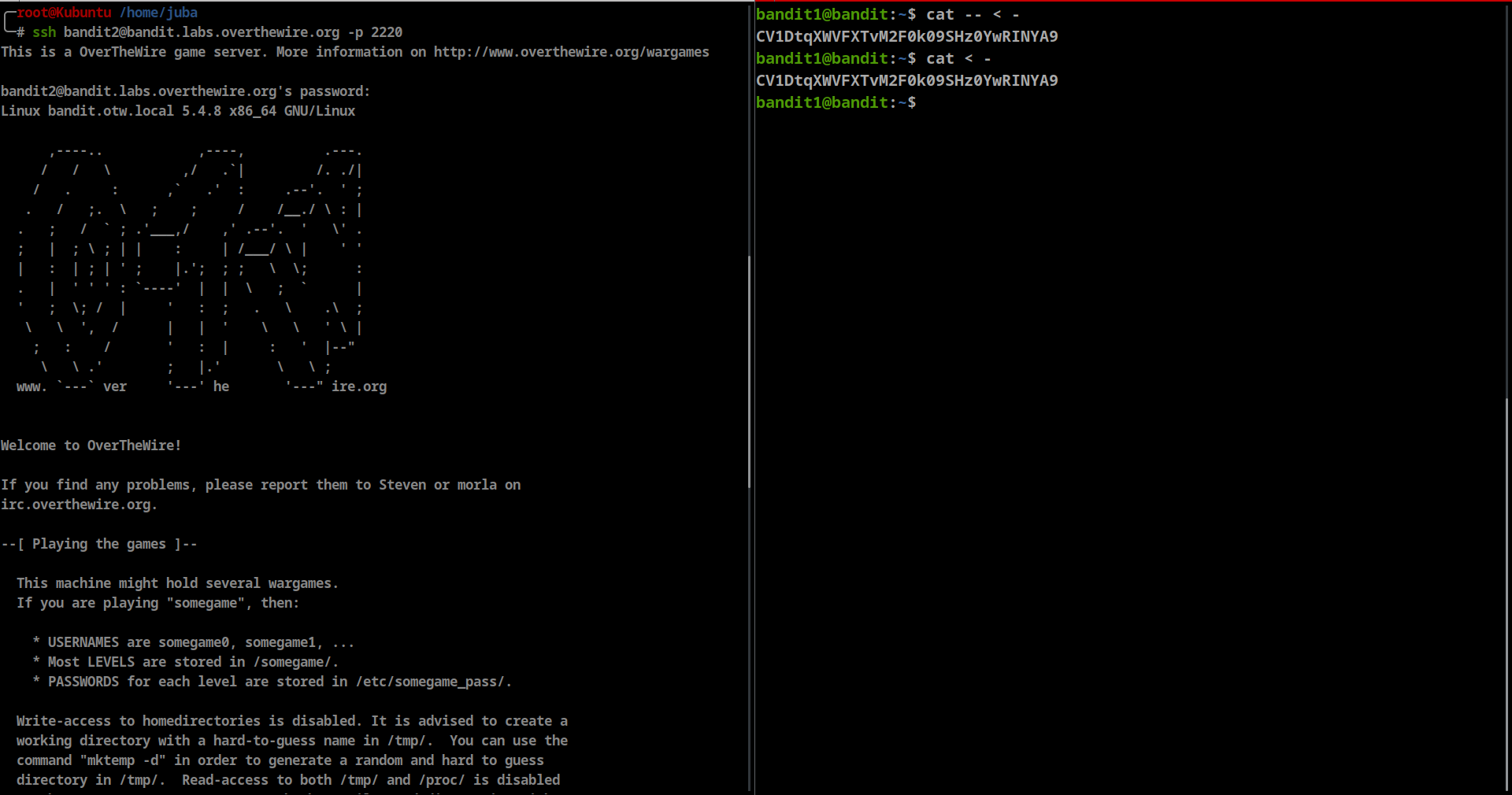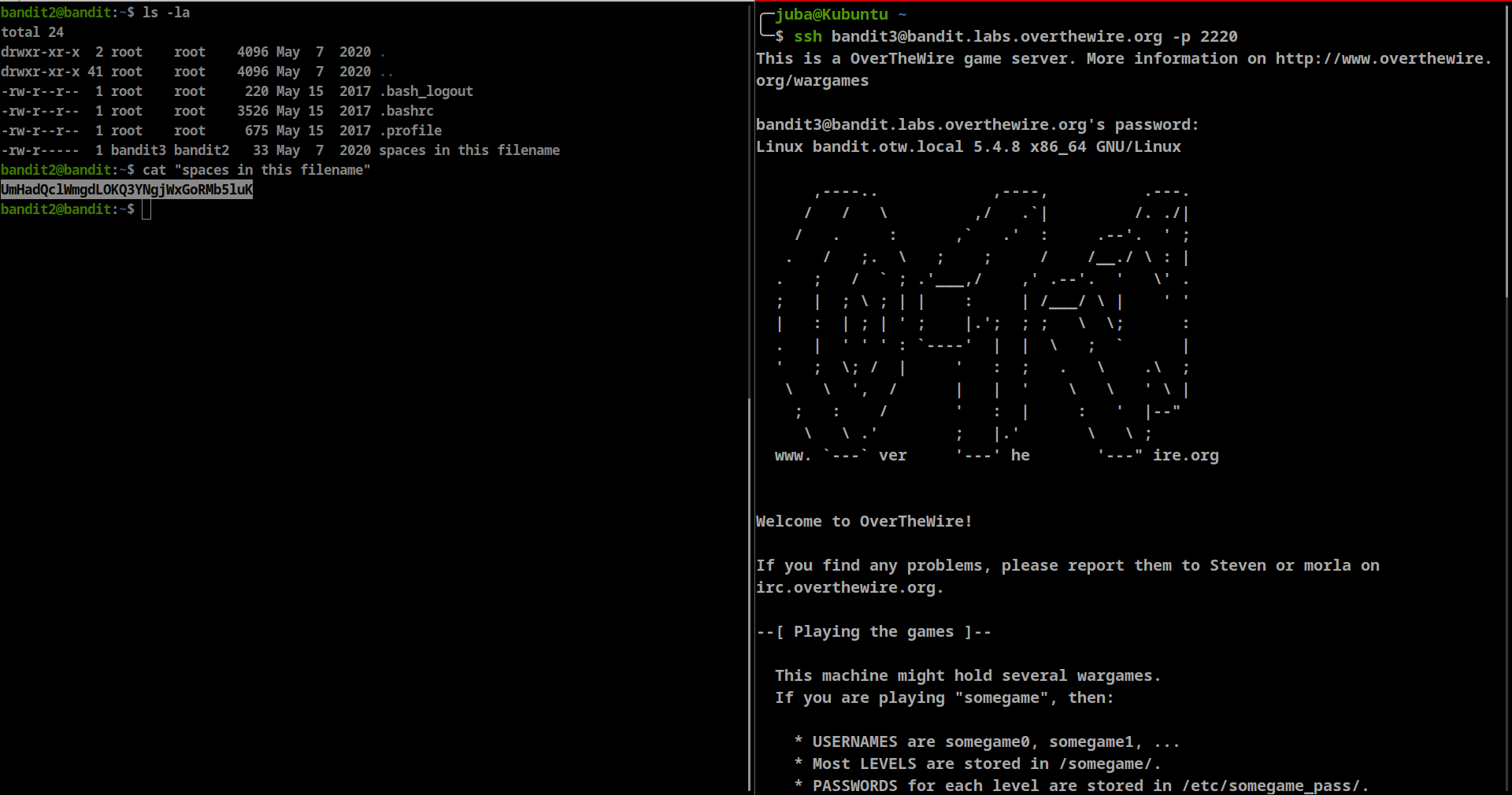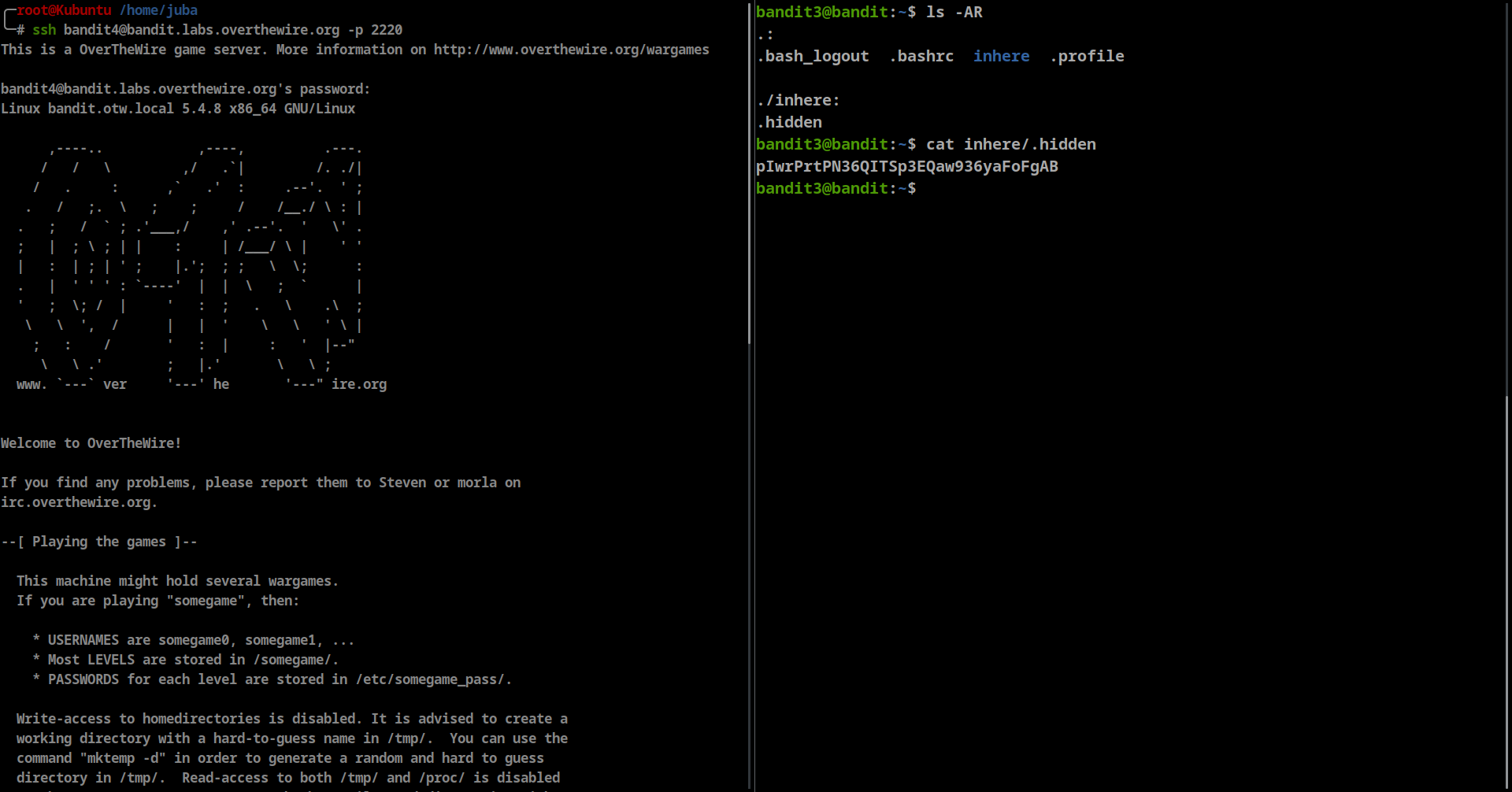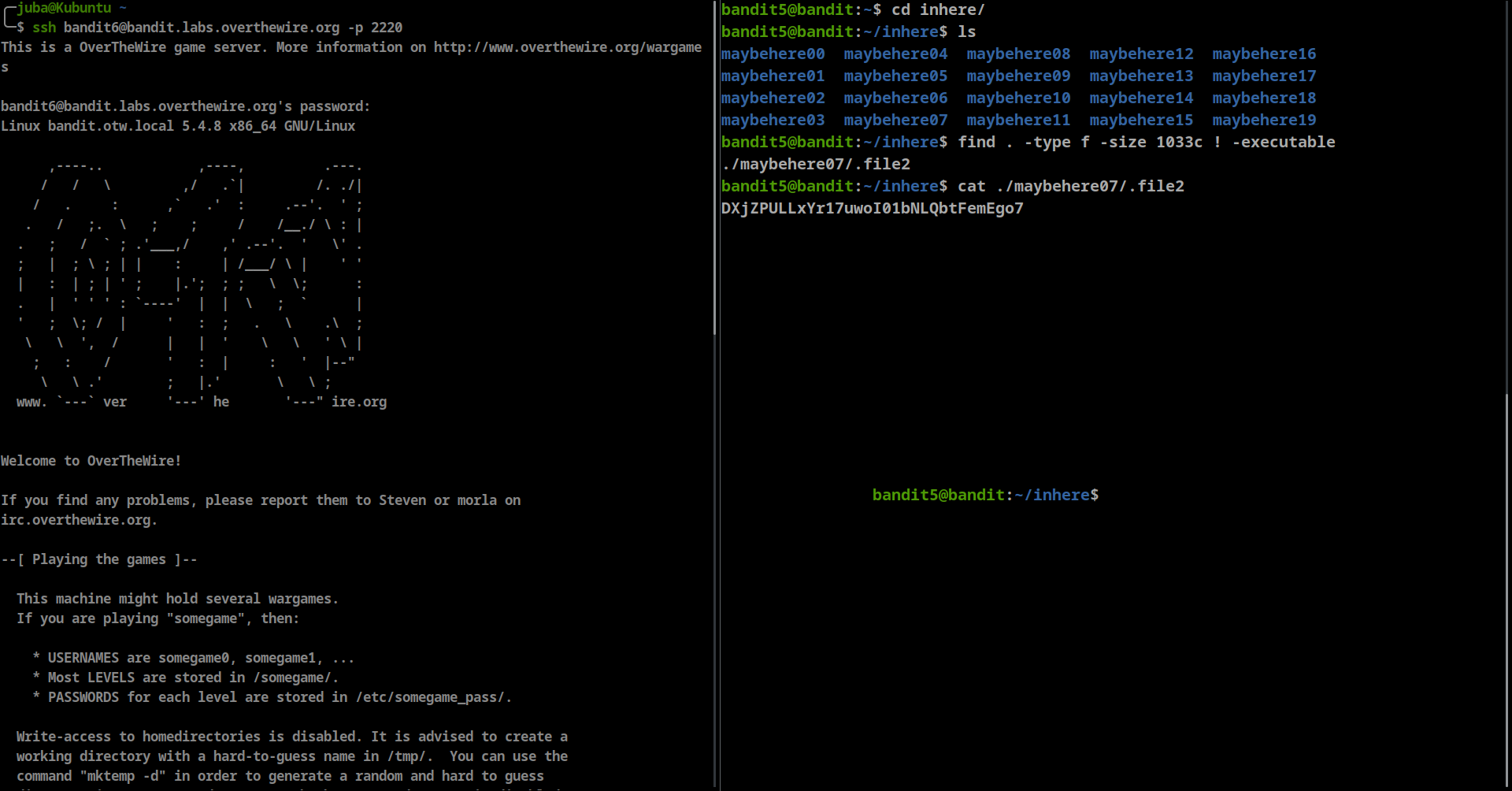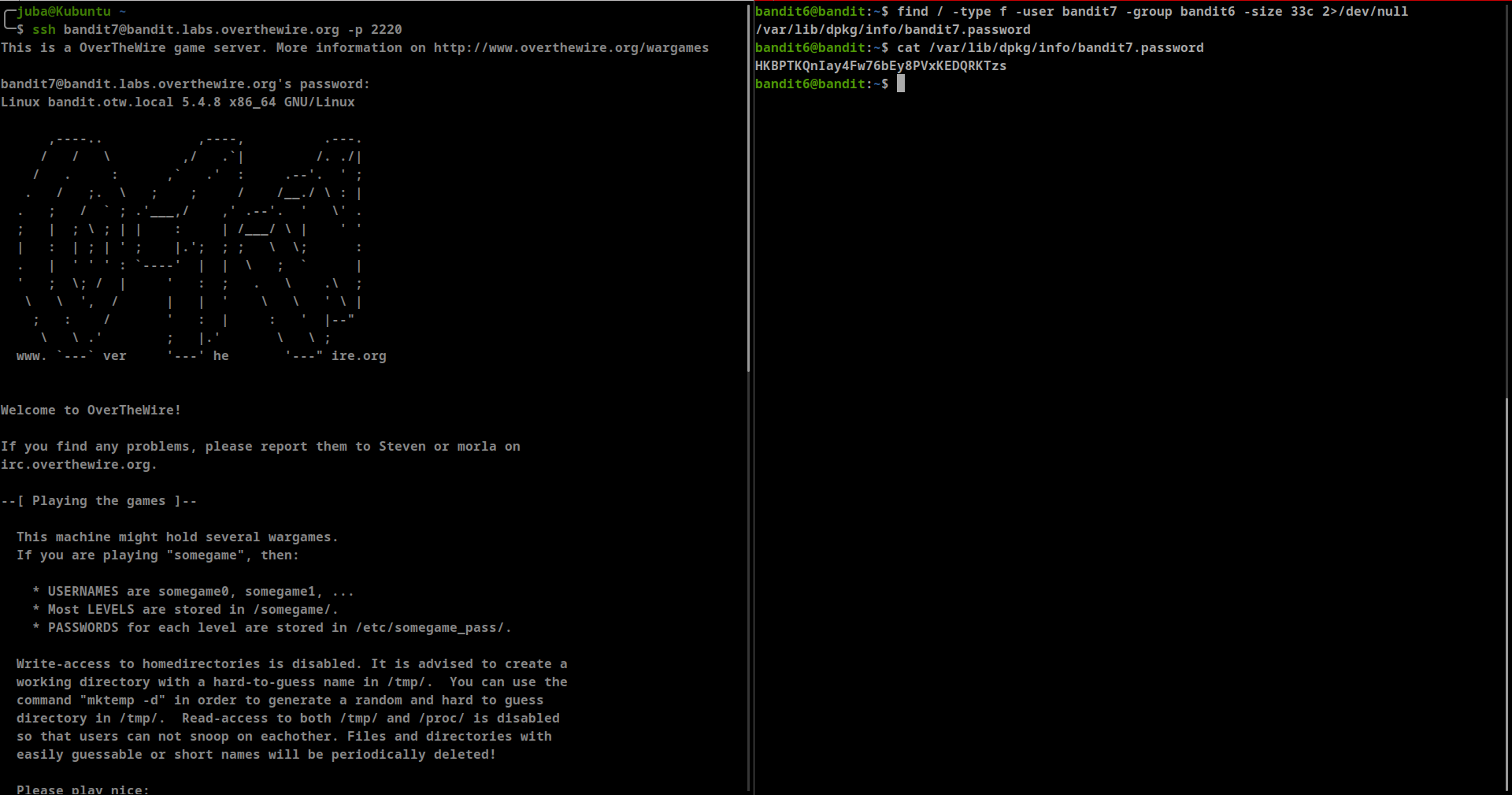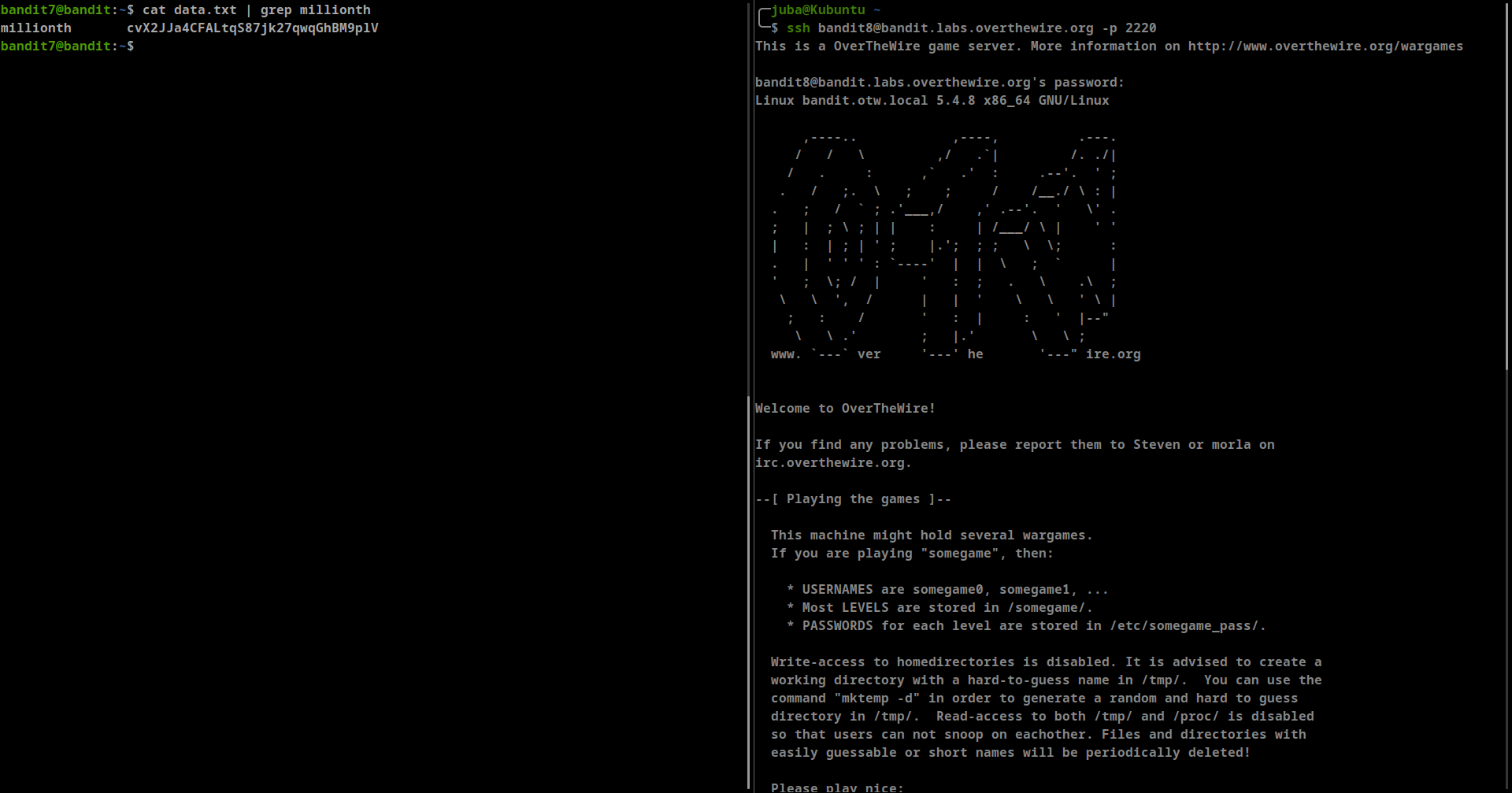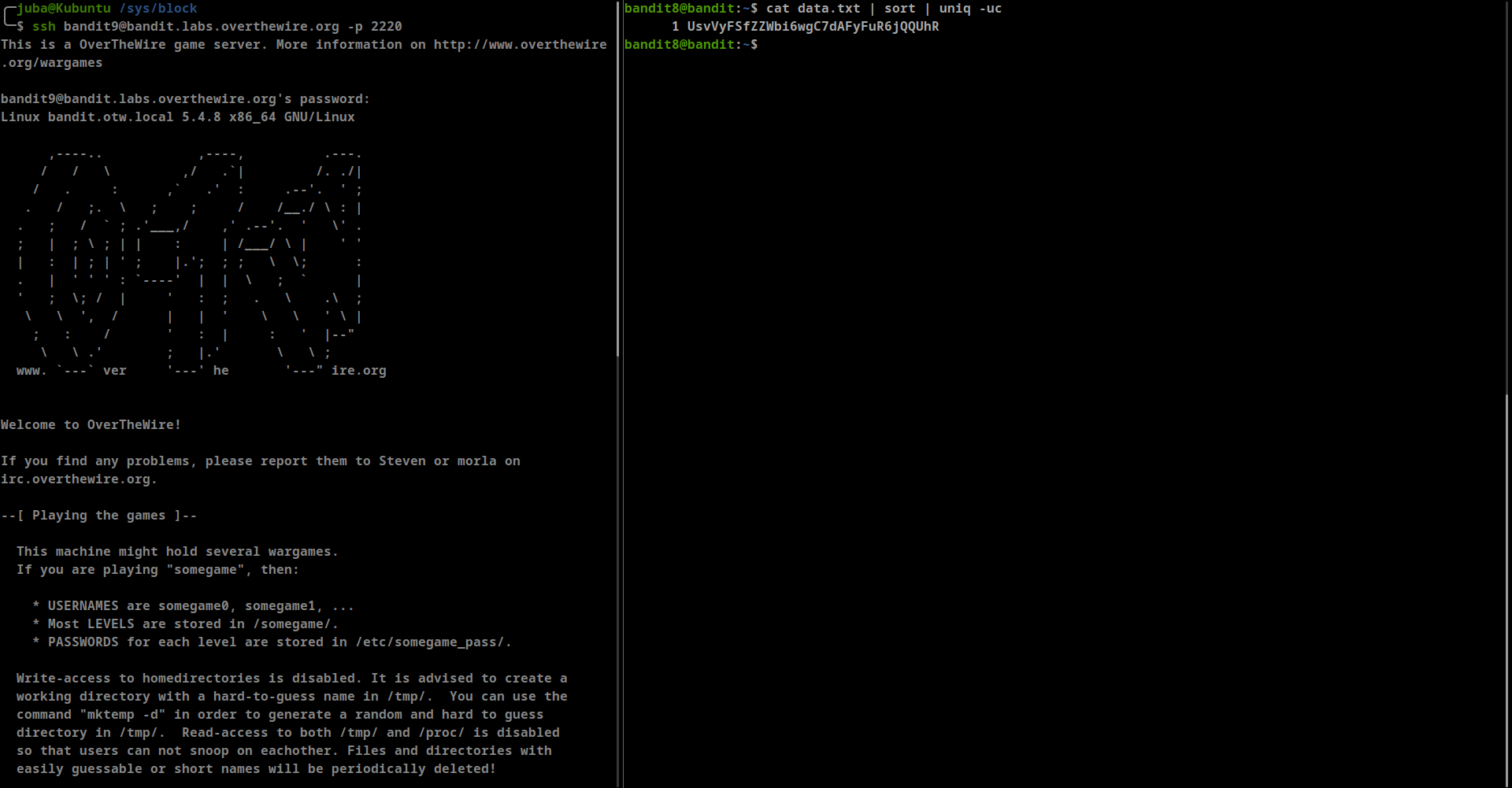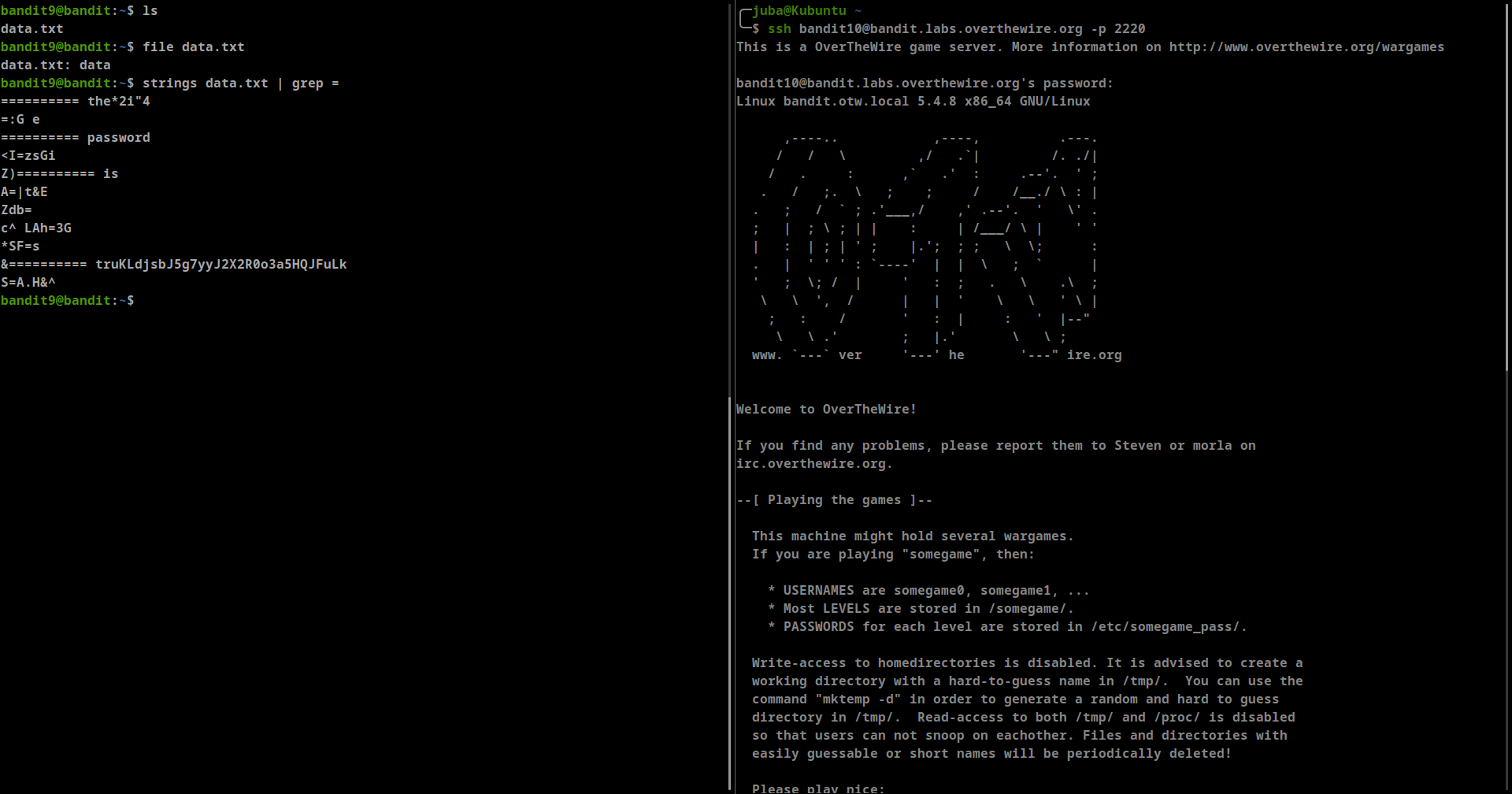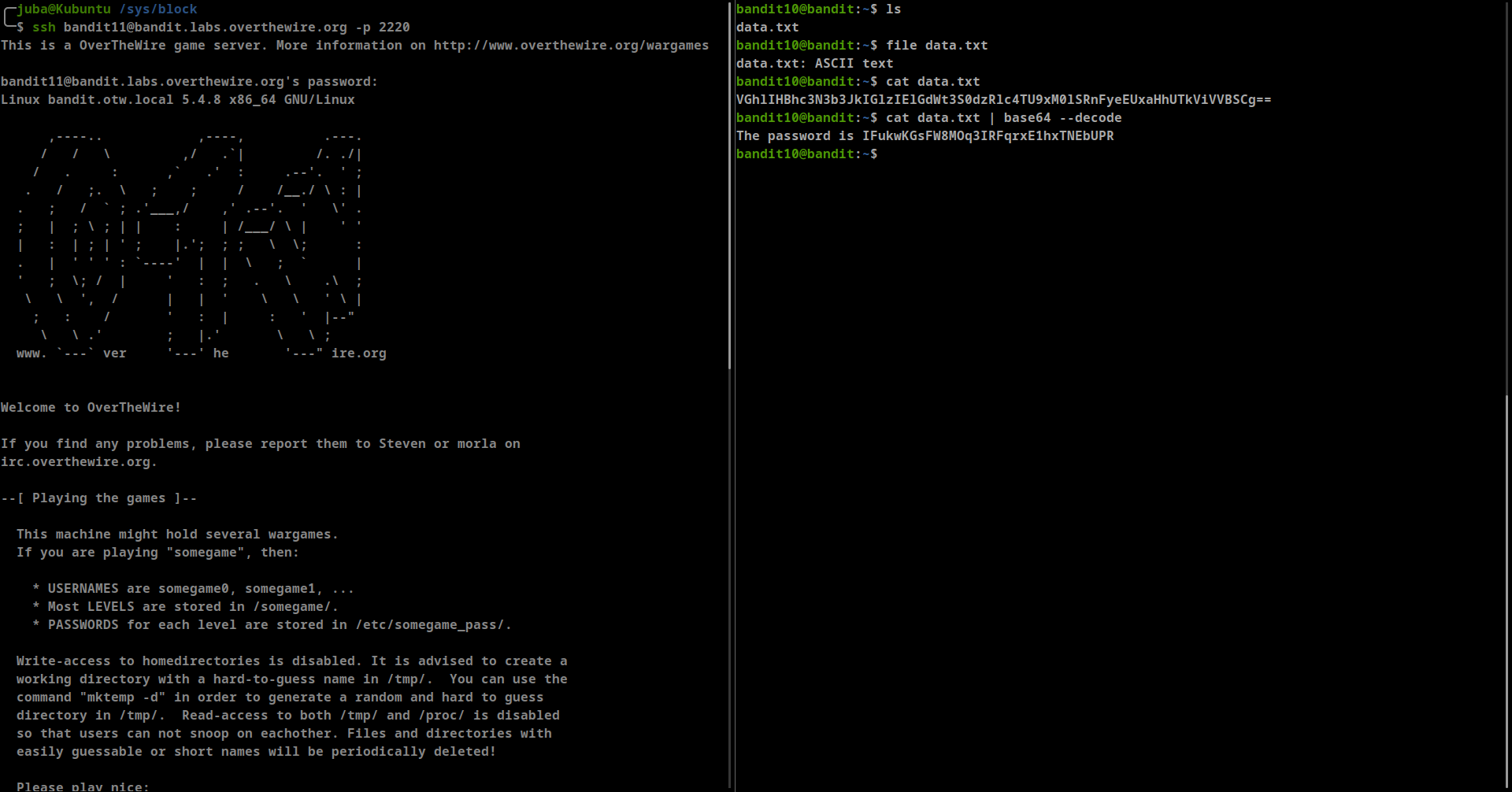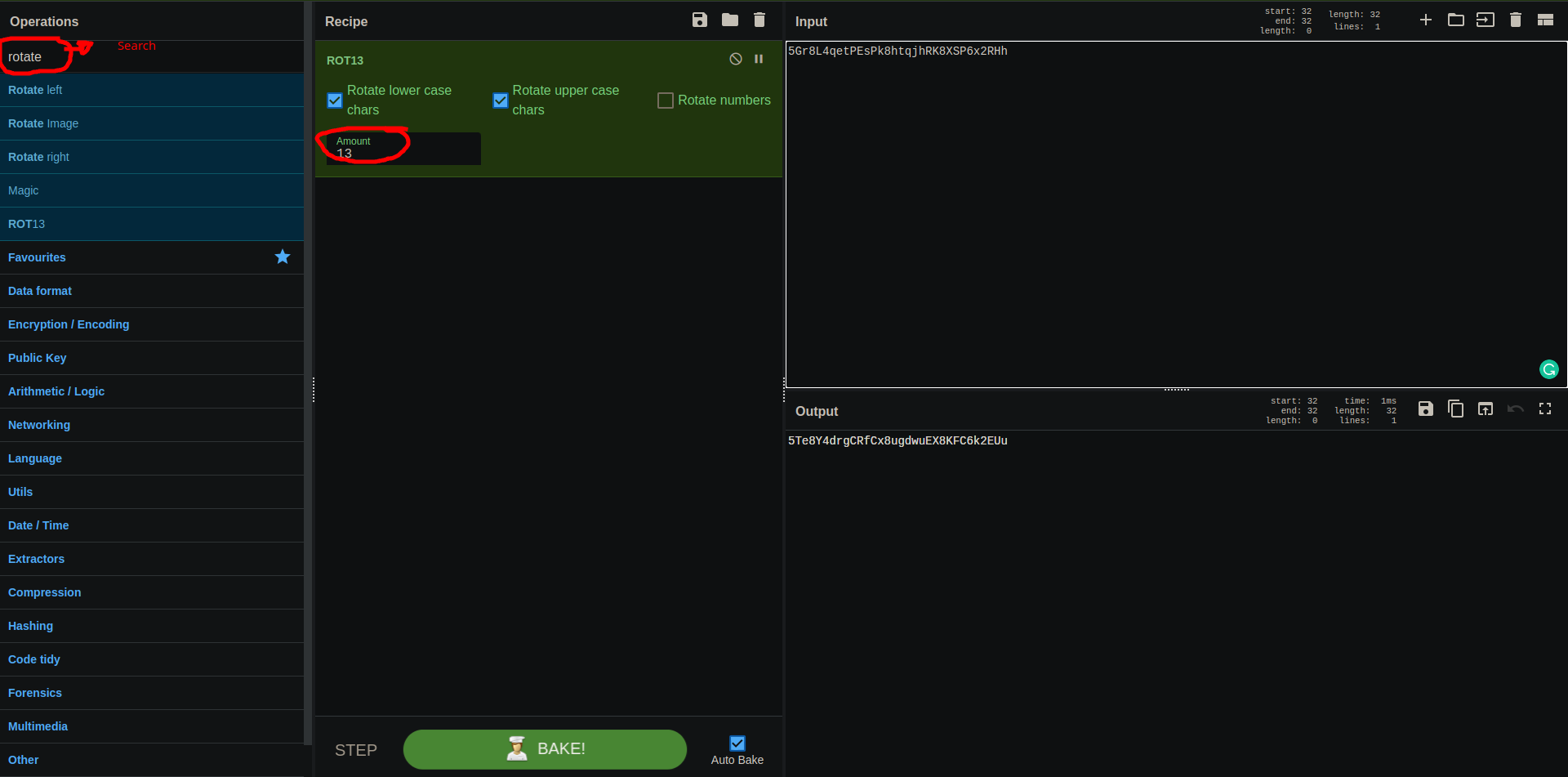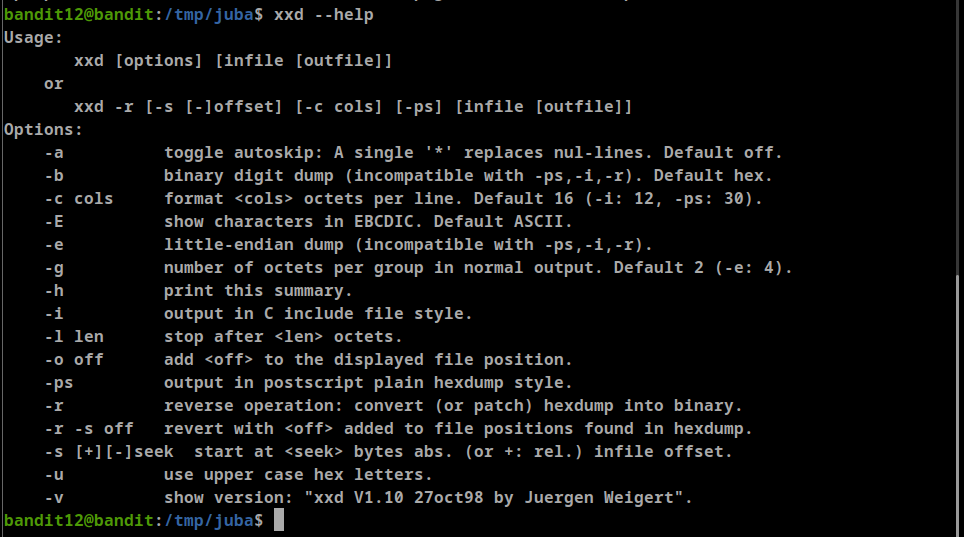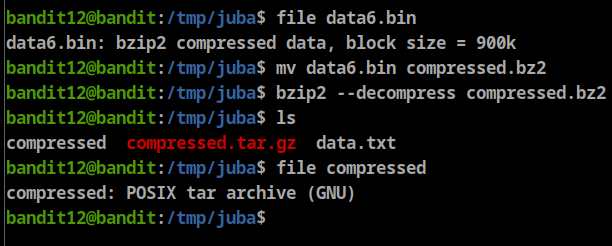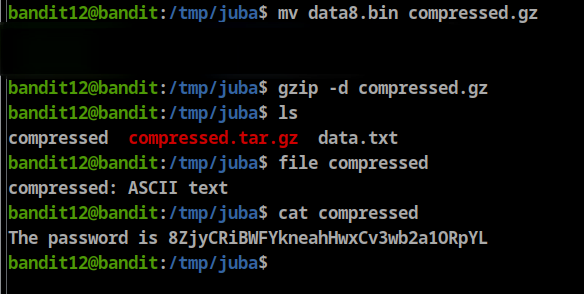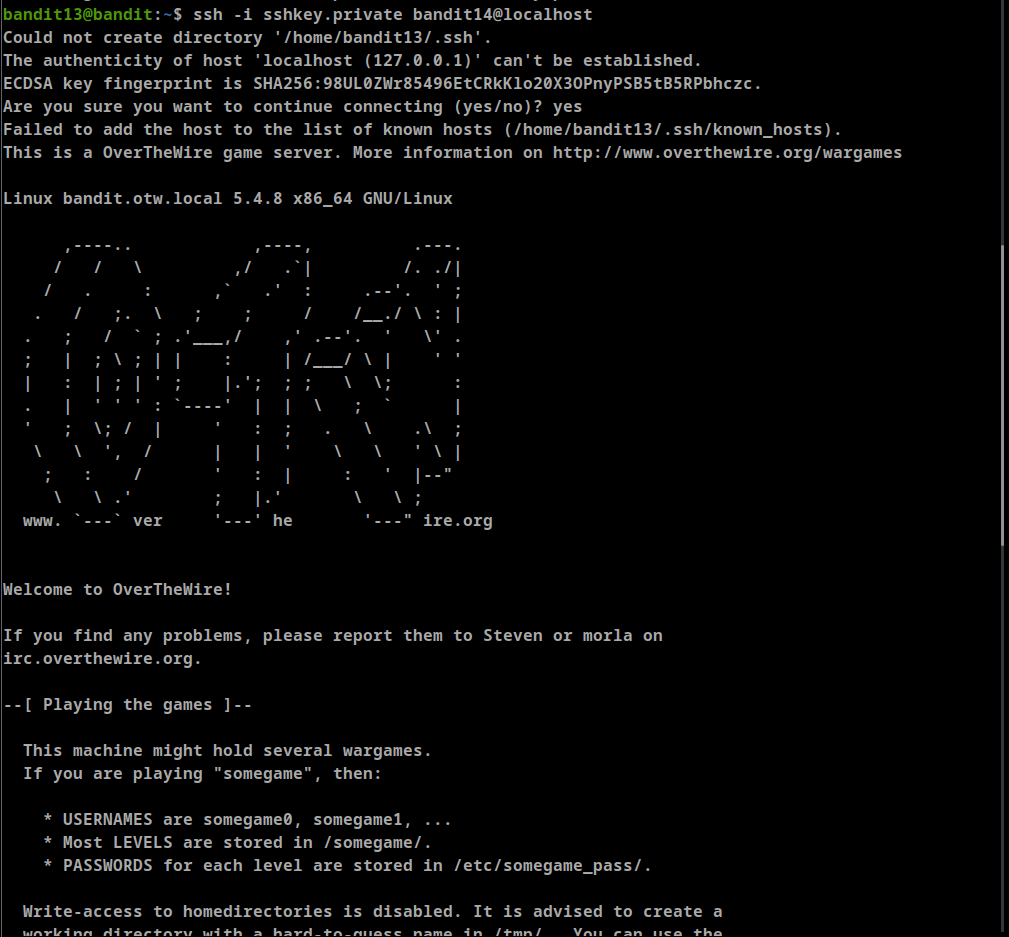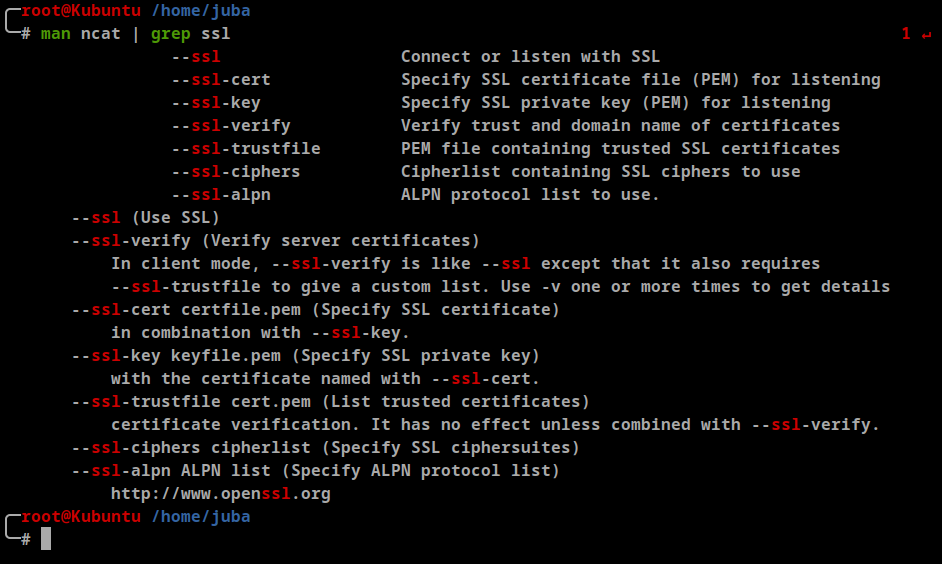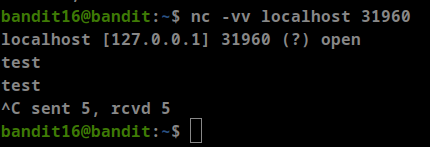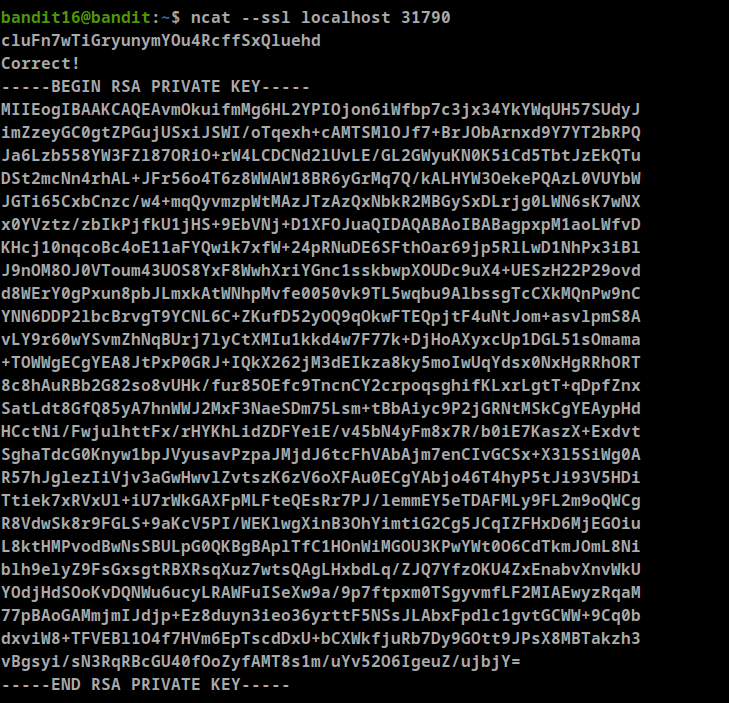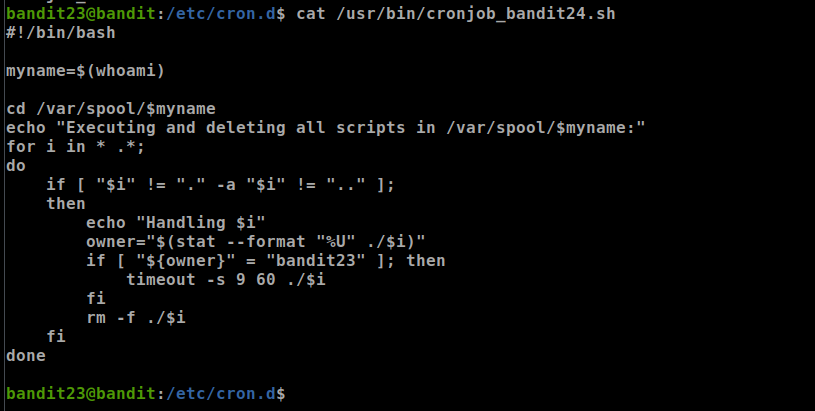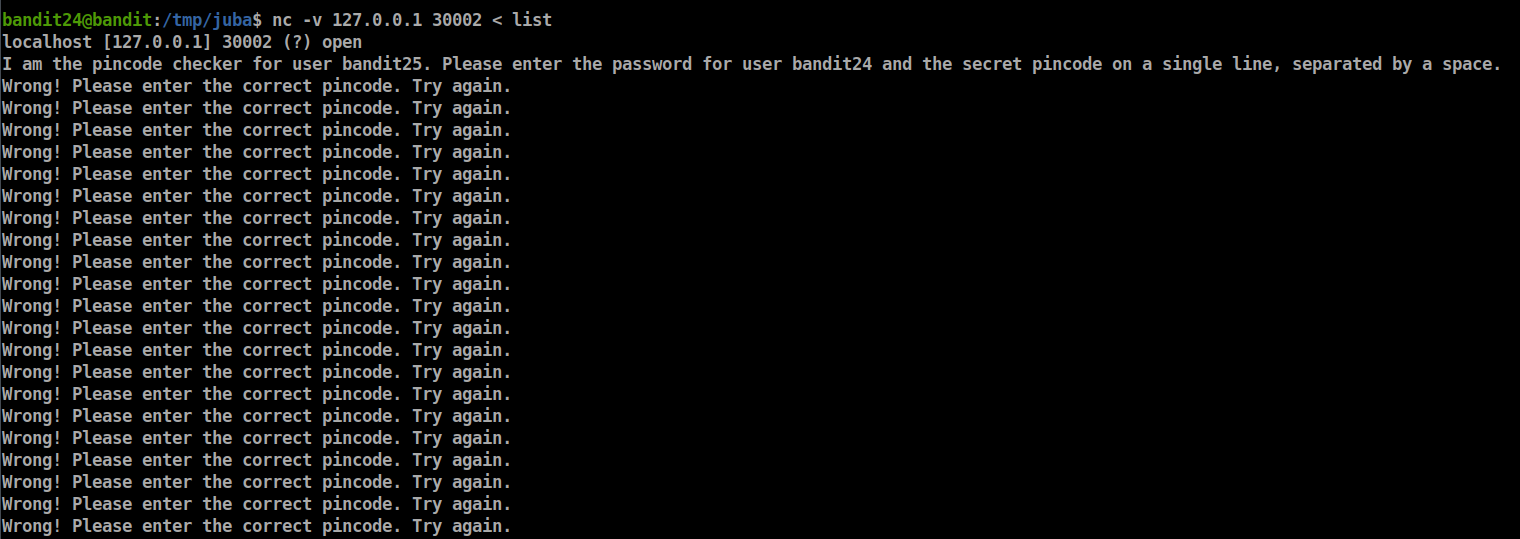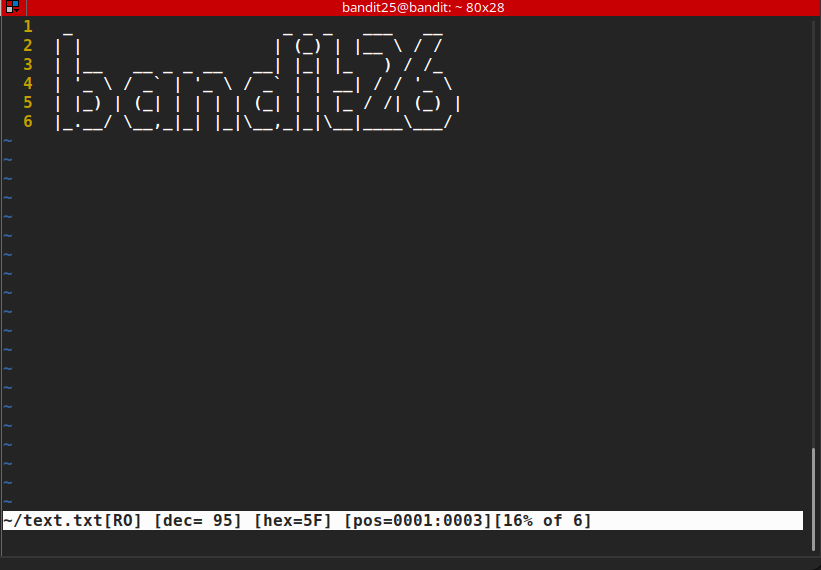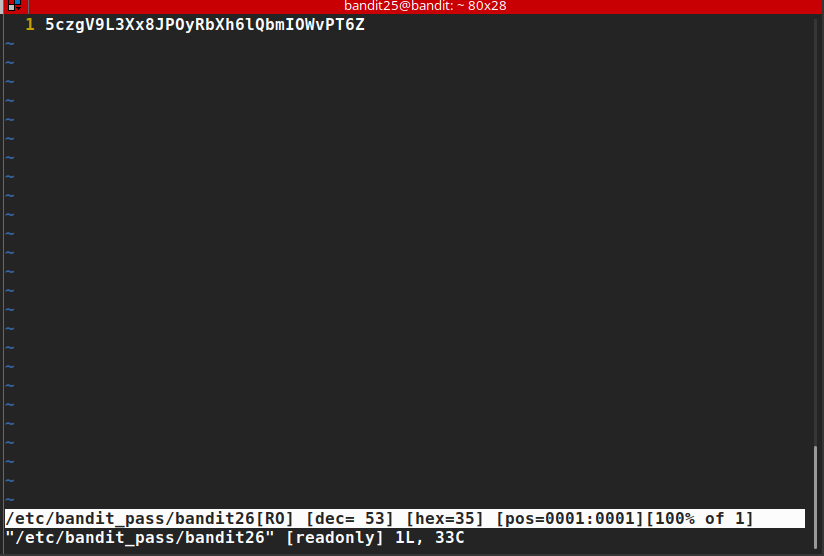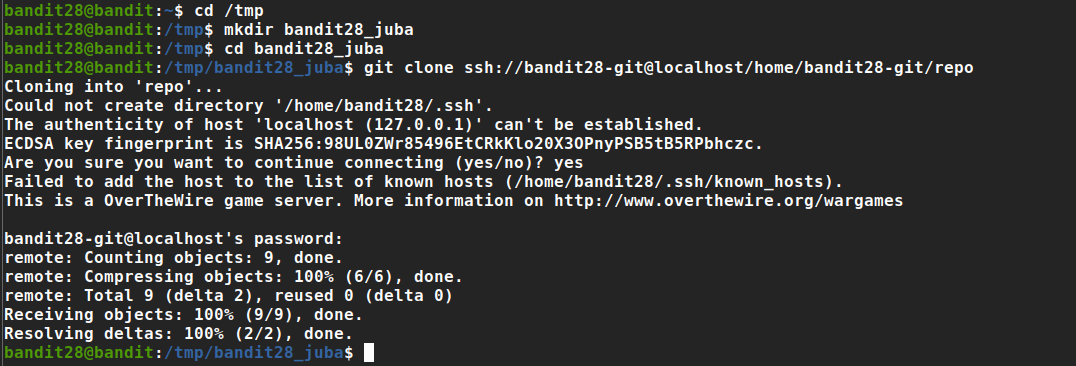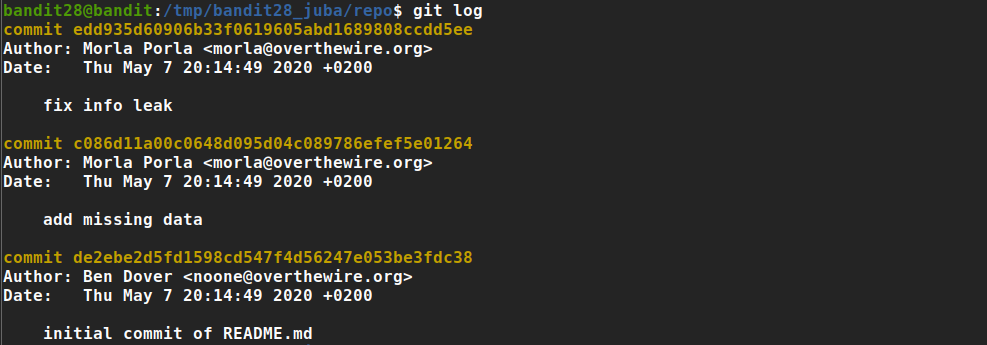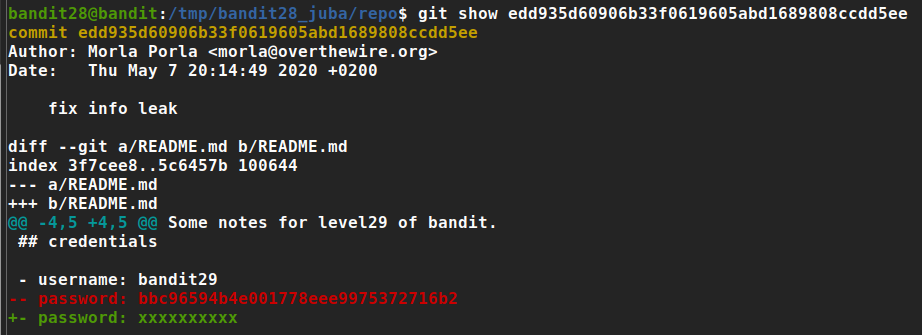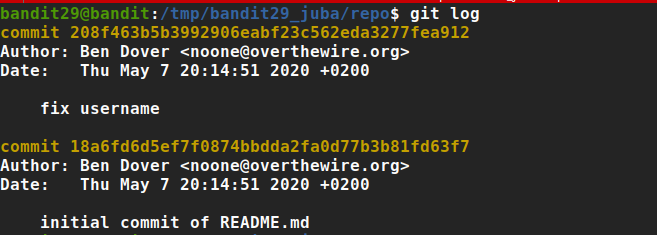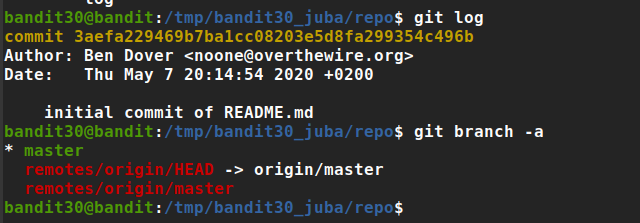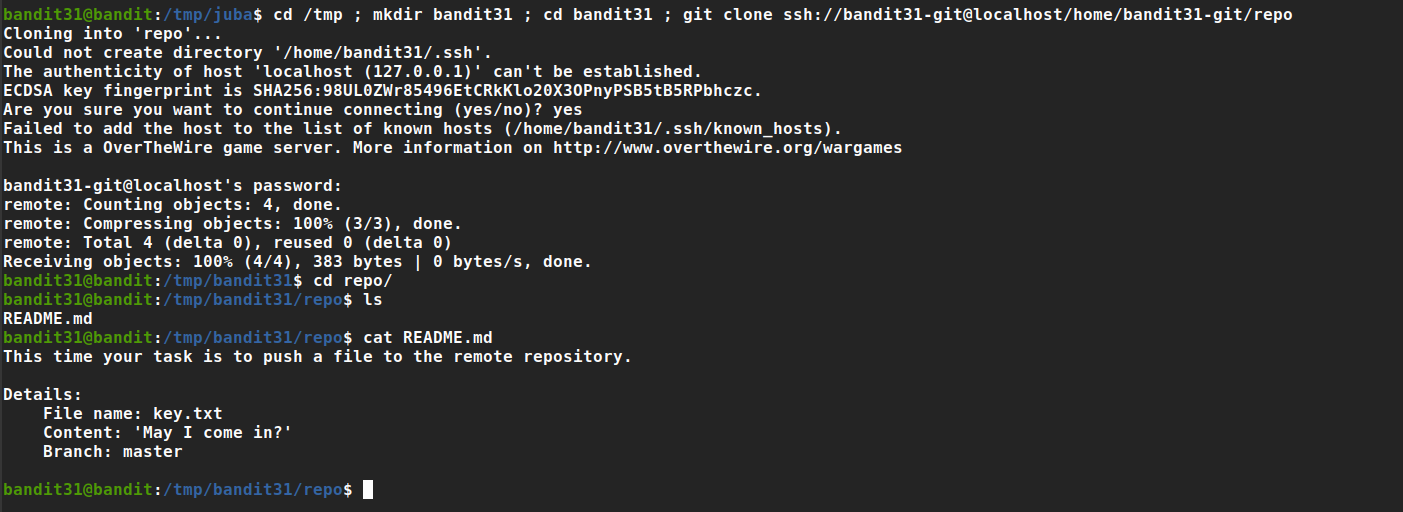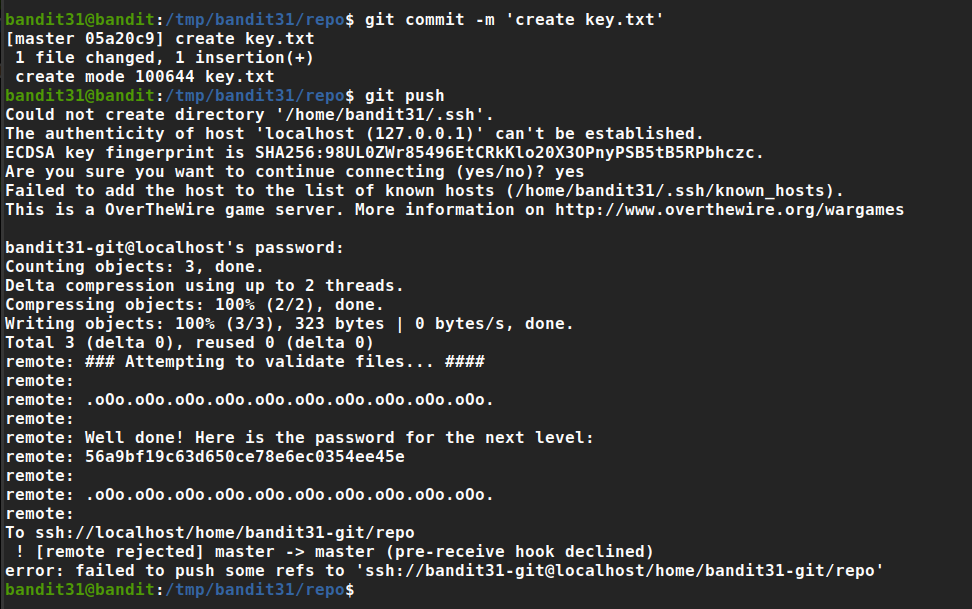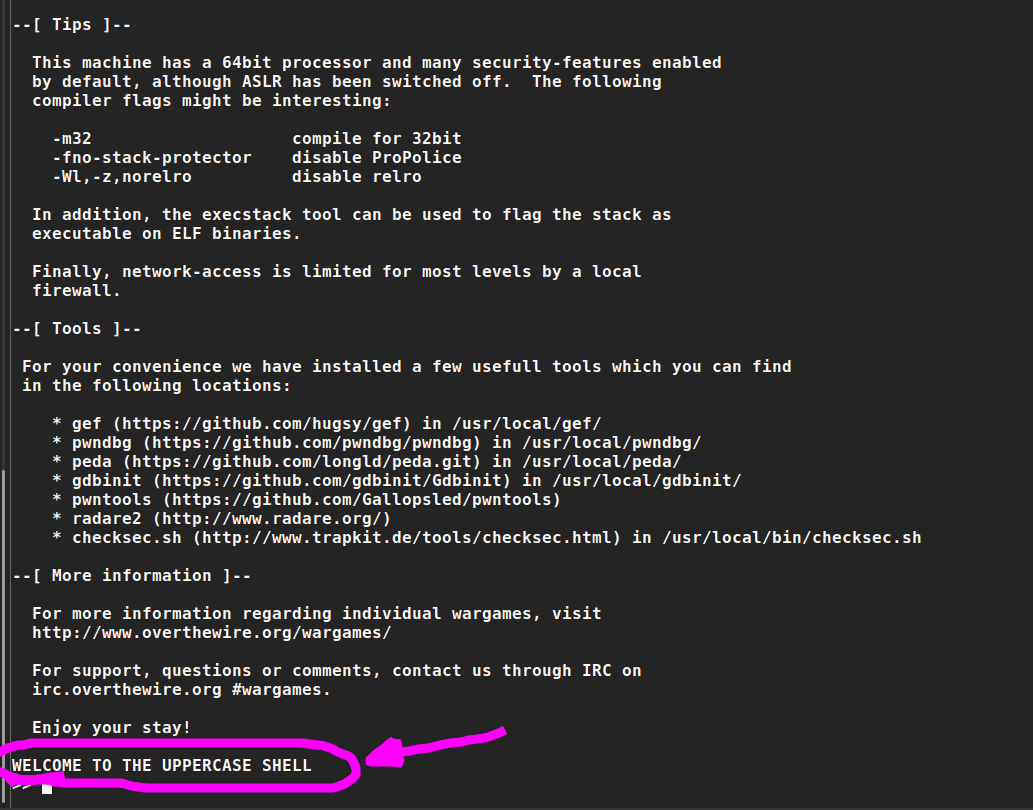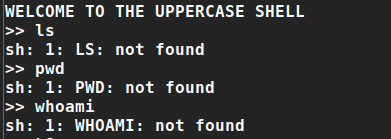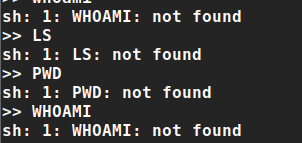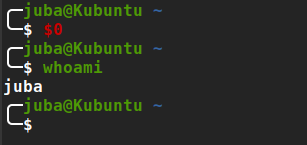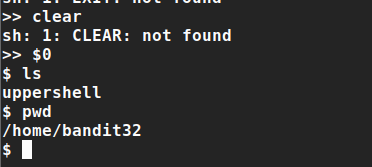OverTheWire - Bandit
Bandit 0
Bandit 0 → Bandit 1
The password for the next level is stored in a file called readme located in the home directory. Use this password to log into bandit1 using SSH. Whenever you find a password for a level, use SSH (on port 2220) to log into that level and continue the game.
Bandit 1 → Bandit 2
The password for the next level is stored in a file called - located in the home directory
- there is many commands will not work like:
- we will use
--to signify the end of command options, so we can show “-” file content - or we can use
<to tellcatget the input from-( STDIN) - password: CV1DtqXWVFXTvM2F0k09SHz0YwRINYA9
Bandit 2 → Bandit 3
The password for the next level is stored in a file called spaces in this filename located in the home directory
- password: UmHadQclWmgdLOKQ3YNgjWxGoRMb5luK
we will use double quotes to cat a file that contains spaces in it’s name
Bandit 3 → Bandit 4
The password for the next level is stored in a hidden file in the inhere directory.
- we will use ls with -AR options
- -A Almost all don’t list . and ..
- -R recursive
- then we cat the file using
**cat inhere/.hidden** - password: pIwrPrtPN36QITSp3EQaw936yaFoFgAB
Bandit 4 → Bandit 5
The password for the next level is stored in the only human-readable file in the inhere directory. Tip: if your terminal is messed up, try the “reset” command.
- first navigate to
inheredirectory - list the files with
lscommand - we can use for loop instead of checking each file individually
for i in {0..9}; do file -- "-file0$i" ; done
- we can see that “-file07” is ASCII file, we can view it’s content using
cat -- -file07command--to say that this is the end of options
- password: koReBOKuIDDepwhWk7jZC0RTdopnAYKh
Bandit 5 → Bandit 6
The password for the next level is stored in a file somewhere under the inhere directory and has all of the following properties:
- human-readable
- 1033 bytes in size
- not executable
- first, navigate to
inheredirectory - list the files
- find a file with size of 1003 bytes and not executable
**find . -type f -size 1033c ! -executable**
- password: DXjZPULLxYr17uwoI01bNLQbtFemEgo7
Bandit 6 → Bandit 7
The password for the next level is stored somewhere on the server and has all of the following properties:
- owned by user bandit7
- owned by group bandit6
- 33 bytes in size
find / -type f -user bandit7 -group bandit6 -size 33c 2>/dev/null- password: HKBPTKQnIay4Fw76bEy8PVxKEDQRKTzs
Bandit 7 → Bandit 8
The password for the next level is stored in the file data.txt next to the word millionth
**cat data.txt | grep millionth**easy command- password: cvX2JJa4CFALtqS87jk27qwqGhBM9plV
Bandit 8 → Bandit 9
The password for the next level is stored in the file data.txt and is the only line of text that occurs only once
**uniq**command, ONLY, identifies the duplicate lines, if they are adjacent to each other. So you know why do we need a command tosortlines first.cat data.txt | sort | uniq -uc- -u → remove duplicate lines
- -c → count
- password: UsvVyFSfZZWbi6wgC7dAFyFuR6jQQUhR
Bandit 9 → Bandit 10
The password for the next level is stored in the file data.txt in one of the few human-readable strings, preceded by several ‘=’ character
- we can see that “data.txt” isn’t an ASCII file so we can use
stringscommand to show any printable character **strings data.txt | grep =**- password: truKLdjsbJ5g7yyJ2X2R0o3a5HQJFuLk
Bandit 10 → Bandit 11
The password for the next level is stored in the file data.txt, which contains base64 encoded data
**cat data.txt | base64 -d**- password: IFukwKGsFW8MOq3IRFqrxE1hxTNEbUPR
Bandit 11 → Bandit 12
The password for the next level is stored in the file data.txt, where all lowercase (a-z) and uppercase (A-Z) letters have been rotated by 13 positions
- first view the content of data.txt
- we can use CyberChef to rotate the letters
- search for rotate in the top left bar then drag ROT13 and drop it in the Recipe section then paste the letters we found in the file data.txt
- password: 5Te8Y4drgCRfCx8ugdwuEX8KFC6k2EUu
- login to bandit 12 using the password
Bandit 12→ Bandit 13
The password for the next level is stored in the file data.txt, which is a hexdump of a file that has been repeatedly compressed. For this level it may be useful to create a directory under /tmp in which you can work using mkdir. For example: mkdir /tmp/myname123. Then copy the datafile using cp, and rename it using mv (read the manpages!)
- first, we will create a directory inside /tmp
cp data.txt to our directory
- alright, let’s search for any program to deal with hexdump
we can use
**apropos hexdump**- great, it seems
xxdwill help us here lets learn more about it using
--helpoption- we found
-roption allow us to reverse xxd -r data.txt > datareverse the hexdump and redirect the output to “data” file
- we found
let’s check the file type using
file datacommand, it’s gzip compressed data, so we will rename the file to “data.gz”- unzip “data.gz” using
gzip --decompress data.gz
- unzip “data.gz” using
there are three steps we will do after any decompress
- Chck the file format using
**file <file name>** - rename the file with it’s format extention (gzip → .gz, bzip2 → bz2, POSIX → tar.gz)
- decompress the file (
gzip -dortar -xvforbzip2 -d)
- Chck the file format using
gzip decompress
- bzip2 decompress
after checking the file type again we will see it is bzip2 file, so let’s rename the file to “data.bz2”
**bandit12@bandit:/tmp/juba$ mv compressed.bz compressed.bz2**
gzip decompress
Tar decompress
POSIX tar decompress
bzip2 decompress
tar decompress
gzip decompress
- Password: 8ZjyCRiBWFYkneahHwxCv3wb2a1ORpYL
Bandit 13 → Bandit 14
- The password for the next level is stored in /etc/bandit_pass/bandit14 and can only be read by user bandit14. For this level, you don’t get the next password, but you get a private SSH key that can be used to log into the next level. Note: localhost is a hostname that refers to the machine you are working on
- We don’t need the Bandit14 password, we have his ssh private key, so we can use it to login
**ssh -i <ssh key> <username>@<host>**
1
2
3
4
5
6
7
8
9
10
11
12
13
14
15
16
17
18
19
20
21
22
23
24
25
26
27
-----BEGIN RSA PRIVATE KEY-----
MIIEpAIBAAKCAQEAxkkOE83W2cOT7IWhFc9aPaaQmQDdgzuXCv+ppZHa++buSkN+
gg0tcr7Fw8NLGa5+Uzec2rEg0WmeevB13AIoYp0MZyETq46t+jk9puNwZwIt9XgB
ZufGtZEwWbFWw/vVLNwOXBe4UWStGRWzgPpEeSv5Tb1VjLZIBdGphTIK22Amz6Zb
ThMsiMnyJafEwJ/T8PQO3myS91vUHEuoOMAzoUID4kN0MEZ3+XahyK0HJVq68KsV
ObefXG1vvA3GAJ29kxJaqvRfgYnqZryWN7w3CHjNU4c/2Jkp+n8L0SnxaNA+WYA7
jiPyTF0is8uzMlYQ4l1Lzh/8/MpvhCQF8r22dwIDAQABAoIBAQC6dWBjhyEOzjeA
J3j/RWmap9M5zfJ/wb2bfidNpwbB8rsJ4sZIDZQ7XuIh4LfygoAQSS+bBw3RXvzE
pvJt3SmU8hIDuLsCjL1VnBY5pY7Bju8g8aR/3FyjyNAqx/TLfzlLYfOu7i9Jet67
xAh0tONG/u8FB5I3LAI2Vp6OviwvdWeC4nOxCthldpuPKNLA8rmMMVRTKQ+7T2VS
nXmwYckKUcUgzoVSpiNZaS0zUDypdpy2+tRH3MQa5kqN1YKjvF8RC47woOYCktsD
o3FFpGNFec9Taa3Msy+DfQQhHKZFKIL3bJDONtmrVvtYK40/yeU4aZ/HA2DQzwhe
ol1AfiEhAoGBAOnVjosBkm7sblK+n4IEwPxs8sOmhPnTDUy5WGrpSCrXOmsVIBUf
laL3ZGLx3xCIwtCnEucB9DvN2HZkupc/h6hTKUYLqXuyLD8njTrbRhLgbC9QrKrS
M1F2fSTxVqPtZDlDMwjNR04xHA/fKh8bXXyTMqOHNJTHHNhbh3McdURjAoGBANkU
1hqfnw7+aXncJ9bjysr1ZWbqOE5Nd8AFgfwaKuGTTVX2NsUQnCMWdOp+wFak40JH
PKWkJNdBG+ex0H9JNQsTK3X5PBMAS8AfX0GrKeuwKWA6erytVTqjOfLYcdp5+z9s
8DtVCxDuVsM+i4X8UqIGOlvGbtKEVokHPFXP1q/dAoGAcHg5YX7WEehCgCYTzpO+
xysX8ScM2qS6xuZ3MqUWAxUWkh7NGZvhe0sGy9iOdANzwKw7mUUFViaCMR/t54W1
GC83sOs3D7n5Mj8x3NdO8xFit7dT9a245TvaoYQ7KgmqpSg/ScKCw4c3eiLava+J
3btnJeSIU+8ZXq9XjPRpKwUCgYA7z6LiOQKxNeXH3qHXcnHok855maUj5fJNpPbY
iDkyZ8ySF8GlcFsky8Yw6fWCqfG3zDrohJ5l9JmEsBh7SadkwsZhvecQcS9t4vby
9/8X4jS0P8ibfcKS4nBP+dT81kkkg5Z5MohXBORA7VWx+ACohcDEkprsQ+w32xeD
qT1EvQKBgQDKm8ws2ByvSUVs9GjTilCajFqLJ0eVYzRPaY6f++Gv/UVfAPV4c+S0
kAWpXbv5tbkkzbS0eaLPTKgLzavXtQoTtKwrjpolHKIHUz6Wu+n4abfAIRFubOdN
/+aLoRQ0yBDRbdXMsZN/jvY44eM+xRLdRVyMmdPtP8belRi2E2aEzA==
-----END RSA PRIVATE KEY-----
Bandit 14 → Bandit 15
- The password for the next level can be retrieved by submitting the password of the current level to port 30000 on localhost.
we know from the previous task that bandit14 password is stored in /etc/bandit_pass/bandit14
- Bandit14 password: 4wcYUJFw0k0XLShlDzztnTBHiqxU3b3e
as we can see if we get the content of the website we can’t see the password unless we submit our password
we can use netcat to submit our password
Password: BfMYroe26WYalil77FoDi9qh59eK5xNr
Bandit 15 → Bandit 16
- The password for the next level can be retrieved by submitting the password of the current level to port 30001 on localhost using SSL encryption.
- Helpful note: Getting “HEARTBEATING” and “Read R BLOCK”? Use -ign_eof and read the “CONNECTED COMMANDS” section in the manpage. Next to ‘R’ and ‘Q’, the ‘B’ command also works in this version of that command…
Let’s check the manual page for netcat using
mancommand- can’t find any helpful option
let’s try ncat
- Great point, now we can use ncat
**ncat --ssl 127.0.0.1 30001**- Password: cluFn7wTiGryunymYOu4RcffSxQluehd
Bandit 16 → Bandit 17
- The credentials for the next level can be retrieved by submitting the password of the current level to a port on localhost in the range 31000 to 32000
- First, find out which of these ports have a server listening on them. Then find out which of those speak SSL and which don’t. There is only 1 server that will give the next credentials, the others will simply send back to you whatever you send to it.
Start nmap scan using -p to specify the ports
we can check them manually
as we can see there are two ports that use SSL (31518, 31790), Let’s check them
- it seems this is the wrong one
port 31790
1
2
3
4
5
6
7
8
9
10
11
12
13
14
15
16
17
18
19
20
21
22
23
24
25
26
27
-----BEGIN RSA PRIVATE KEY-----
MIIEogIBAAKCAQEAvmOkuifmMg6HL2YPIOjon6iWfbp7c3jx34YkYWqUH57SUdyJ
imZzeyGC0gtZPGujUSxiJSWI/oTqexh+cAMTSMlOJf7+BrJObArnxd9Y7YT2bRPQ
Ja6Lzb558YW3FZl87ORiO+rW4LCDCNd2lUvLE/GL2GWyuKN0K5iCd5TbtJzEkQTu
DSt2mcNn4rhAL+JFr56o4T6z8WWAW18BR6yGrMq7Q/kALHYW3OekePQAzL0VUYbW
JGTi65CxbCnzc/w4+mqQyvmzpWtMAzJTzAzQxNbkR2MBGySxDLrjg0LWN6sK7wNX
x0YVztz/zbIkPjfkU1jHS+9EbVNj+D1XFOJuaQIDAQABAoIBABagpxpM1aoLWfvD
KHcj10nqcoBc4oE11aFYQwik7xfW+24pRNuDE6SFthOar69jp5RlLwD1NhPx3iBl
J9nOM8OJ0VToum43UOS8YxF8WwhXriYGnc1sskbwpXOUDc9uX4+UESzH22P29ovd
d8WErY0gPxun8pbJLmxkAtWNhpMvfe0050vk9TL5wqbu9AlbssgTcCXkMQnPw9nC
YNN6DDP2lbcBrvgT9YCNL6C+ZKufD52yOQ9qOkwFTEQpjtF4uNtJom+asvlpmS8A
vLY9r60wYSvmZhNqBUrj7lyCtXMIu1kkd4w7F77k+DjHoAXyxcUp1DGL51sOmama
+TOWWgECgYEA8JtPxP0GRJ+IQkX262jM3dEIkza8ky5moIwUqYdsx0NxHgRRhORT
8c8hAuRBb2G82so8vUHk/fur85OEfc9TncnCY2crpoqsghifKLxrLgtT+qDpfZnx
SatLdt8GfQ85yA7hnWWJ2MxF3NaeSDm75Lsm+tBbAiyc9P2jGRNtMSkCgYEAypHd
HCctNi/FwjulhttFx/rHYKhLidZDFYeiE/v45bN4yFm8x7R/b0iE7KaszX+Exdvt
SghaTdcG0Knyw1bpJVyusavPzpaJMjdJ6tcFhVAbAjm7enCIvGCSx+X3l5SiWg0A
R57hJglezIiVjv3aGwHwvlZvtszK6zV6oXFAu0ECgYAbjo46T4hyP5tJi93V5HDi
Ttiek7xRVxUl+iU7rWkGAXFpMLFteQEsRr7PJ/lemmEY5eTDAFMLy9FL2m9oQWCg
R8VdwSk8r9FGLS+9aKcV5PI/WEKlwgXinB3OhYimtiG2Cg5JCqIZFHxD6MjEGOiu
L8ktHMPvodBwNsSBULpG0QKBgBAplTfC1HOnWiMGOU3KPwYWt0O6CdTkmJOmL8Ni
blh9elyZ9FsGxsgtRBXRsqXuz7wtsQAgLHxbdLq/ZJQ7YfzOKU4ZxEnabvXnvWkU
YOdjHdSOoKvDQNWu6ucyLRAWFuISeXw9a/9p7ftpxm0TSgyvmfLF2MIAEwyzRqaM
77pBAoGAMmjmIJdjp+Ez8duyn3ieo36yrttF5NSsJLAbxFpdlc1gvtGCWW+9Cq0b
dxviW8+TFVEBl1O4f7HVm6EpTscdDxU+bCXWkfjuRb7Dy9GOtt9JPsX8MBTakzh3
vBgsyi/sN3RqRBcGU40fOoZyfAMT8s1m/uYv52O6IgeuZ/ujbjY=
-----END RSA PRIVATE KEY-----
Bandit 17 → Bandit 18
- There are 2 files in the home directory: passwords.old and passwords.new. The password for the next level is in passwords.new and is the only line that has been changed between passwords.old and passwords.new
- NOTE: if you have solved this level and see ‘Byebye!’ when trying to log into bandit18, this is related to the next level, bandit19
- we can use many tools to compare two files like:
vimdiffcommdiff
I’m going to use
vimdiff- we can see line number 42 is different
- to close vimdiff you type
:qa
let’s connect to bandit 18 using the password we found
Password: kfBf3eYk5BPBRzwjqutbbfE887SVc5Yd
- as we can see “Byebye !” indicates that’s we have succeeded
Bandit 18 → Bandit 19
- The password for the next level is stored in a file readme in the homedirectory. Unfortunately, someone has modified .bashrc to log you out when you log in with SSH.
- Let’s search for any option helps us to connect using another shell
- We can see
-toption could help us - Let’s try to connect using
**-t <shell>**
- the
-t shis to change the default shell to the shell because the .bashrc has been changed to exit after starting bash
Password: IueksS7Ubh8G3DCwVzrTd8rAVOwq3M5x
Bandit 19 → Bandit 20
- To gain access to the next level, you should use the setuid binary in the home directory. Execute it without arguments to find out how to use it. The password for this level can be found in the usual place (/etc/bandit_pass) after you have used the setuid binary.
if we check
**whoamiwe can see bandit20 like below:**Let’s get bandit20 password by viewing the /etc/bandit_pass/bandit20 file content
Password: GbKksEFF4yrVs6il55v6gwY5aVje5f0j
Bandit 20 → Bandit 21
- There is a setuid binary in the home directory that does the following: it makes a connection to localhost on the port you specify as a command line argument. It then reads a line of text from the connection and compares it to the password in the previous level (bandit20). If the password is correct, it will transmit the password to the next level (bandit21).
NOTE: Try connecting to your own network daemon to see if it works as you think
- great, we can start listening port with
nc(netcat) Let’s use suconnect to connect to our listening port, then enter bandit20 password
Password: gE269g2h3mw3pwgrj0Ha9Uoqen1c9DGr
Bandit 21 → Bandit 22
- A program is running automatically at regular intervals from cron, the time-based job scheduler. Look in /etc/cron.d/ for the configuration and see what command is being executed.
Let’s check cron.d directory
we can see that bandit22 cronjob in /usr/bin/cronjob_bandit22.sh, so let’s check it
as we can see this script will change the mode to 644 for a file called “t7O6lds9S0RqQh9aMcz6ShpAoZKF7fgv” in /tmp, then will cat bandit22 password and redirect it to this file
It’s very easy to access the password, just read the file “/tmp/t7O6lds9S0RqQh9aMcz6ShpAoZKF7fgv”
Password: Yk7owGAcWjwMVRwrTesJEwB7WVOiILLI
Bandit 22 → Bandit 23
- A program is running automatically at regular intervals from cron, the time-based job scheduler. Look in /etc/cron.d/ for the configuration and see what command is being executed.
- NOTE: Looking at shell scripts written by other people is a very useful skill. The script for this level is intentionally made easy to read. If you are having problems understanding what it does, try executing it to see the debug information it prints.
we can remember cron.d directory from the previous level
let’s check the cronjob_bandit23 file
view /usr/bin/cronjob_bandit23.sh
- line 1: shebang
- line4: save the user name in a variable called myname
- line5: hash the text “I am user username“ using md5sum hash algorithm then split the output and save the output in a variable called mytarget
- line 7: print “Copying password file /etc/bandit_pass/$myname to /tmp/$mytarget”
line 9: cat his password and redirect it to /tmp/$mytarget
- we know that bandit23 is running this cronjob, so it’s obvious that myname variable is “bandit23”, Let’s assign this value using
**myname=bandit23** let’s continue the script by assigning mytarget variable using
mytarget=$(echo I am user $myname | md5sum | cut -d ' ' -f 1)now we know the file name, let’s get the password
Password: jc1udXuA1tiHqjIsL8yaapX5XIAI6i0n
Bandit 23 → Bandit 24
- A program is running automatically at regular intervals from cron, the time-based job scheduler. Look in /etc/cron.d/ for the configuration and see what command is being executed.
- NOTE: This level requires you to create your own first shell script. This is a very big step and you should be proud of yourself when you beat this level!
- NOTE 2: Keep in mind that your shell script is removed once executed, so you may want to keep a copy around…
Let’s navigate to /etc/cron.d to see all cron jobs
- well, let’s show cronjob_bandit24 content
let’s check /usr/bin/cronjob_bandit24.sh
- the main functionality of this script is executing all the files in /var/spool/$myname and deleting them, in our case $myname is bandit24 he executes this script
- let’s write our script and save it in /tmp/our_dir because the script will remove it automatically
- we can create our script by typing
touch <script name>.sh all we need is bandit24 password, so we can type this small script
1 2
#!/bin/bash cat /etc/bandit_pass/bandit24 > /tmp/juba/done
- before coping this script to /var/spool/bandit24 we need to give it executable permissions by typing
chmod a+x get_pass.sh - if bandit24 executes this script he can’t write on /tmp/juba/done so we should give him write permissions
touch done ; chmod a+w done - coping the file
cp get_pass.sh /var/spool/bandit24/ great, we have got the password
Password: UoMYTrfrBFHyQXmg6gzctqAwOmw1IohZ
Bandit 24 → Bandit 25
- A daemon is listening on port 30002 and will give you the password for bandit25 if given the password for bandit24 and a secret numeric 4-digit pincode. There is no way to retrieve the pincode except by going through all of the 10000 combinations, called brute-forcing.
- First, we should generate all the possible combinations of 4 digits, we can generate it using this simple script
for i in {0000..9999}; do echo $i >> wordlist.txt ; done - great, now we have all the possible combinations let’s try to get the password by connecting to port 30002 using netcat
if we connected without any input we will see the following
- sorry, it seems we need bandit24 password too, let’s get it using
cat /etc/bandit_pass/bandit24and regenerate the list usingfor i in {0000..9999}; do echo "UoMYTrfrBFHyQXmg6gzctqAwOmw1IohZ $i" >> list ; done if we tried to brute force the PIN code we will see this
so, let’s remove these lines by adding
**| grep -v 'Try again'**
Password: uNG9O58gUE7snukf3bvZ0rxhtnjzSGzG
Bandit 25 → Bandit 26
Logging in to bandit26 from bandit25 should be fairly easy… The shell for user bandit26 is not /bin/bash, but something else. Find out what it is, how it works, and how to break out of it.
we found bandit26 ssh key in bandit 25 home directory
1 2
bandit25@bandit:~$ ls bandit26.sshkey
we can check the shell for user bandit26 by viewing /etc/passwd file
- as we can see bandit26 uses /usr/bin/showtext shell
let’s try to login using this ssh key
1 2 3 4 5 6 7 8 9 10 11 12 13 14 15 16 17 18 19 20 21 22 23 24 25 26 27 28 29 30 31 32 33 34 35 36 37 38 39 40 41 42 43 44 45 46 47 48 49 50 51 52 53 54 55 56 57 58 59 60 61 62 63 64 65 66 67 68 69 70 71 72 73 74 75 76 77 78 79 80 81 82 83 84 85 86 87 88 89 90 91 92 93 94 95 96 97 98 99 100
bandit25@bandit:~$ ssh -i bandit26.sshkey bandit26@localhost Could not create directory '/home/bandit25/.ssh'. The authenticity of host 'localhost (127.0.0.1)' can't be established. ECDSA key fingerprint is SHA256:98UL0ZWr85496EtCRkKlo20X3OPnyPSB5tB5RPbhczc. Are you sure you want to continue connecting (yes/no)? yes Failed to add the host to the list of known hosts (/home/bandit25/.ssh/known_hosts). This is a OverTheWire game server. More information on http://www.overthewire.org/wargames Linux bandit.otw.local 5.4.8 x86_64 GNU/Linux ,----.. ,----, .---. / / \ ,/ .`| /. ./| / . : ,` .' : .--'. ' ; . / ;. \ ; ; / /__./ \ : | . ; / ` ; .'___,/ ,' .--'. ' \' . ; | ; \ ; | | : | /___/ \ | ' ' | : | ; | ' ; |.'; ; ; \ \; : . | ' ' ' : `----' | | \ ; ` | ' ; \; / | ' : ; . \ .\ ; \ \ ', / | | ' \ \ ' \ | ; : / ' : | : ' |--" \ \ .' ; |.' \ \ ; www. `---` ver '---' he '---" ire.org Welcome to OverTheWire! If you find any problems, please report them to Steven or morla on irc.overthewire.org. --[ Playing the games ]-- This machine might hold several wargames. If you are playing "somegame", then: * USERNAMES are somegame0, somegame1, ... * Most LEVELS are stored in /somegame/. * PASSWORDS for each level are stored in /etc/somegame_pass/. Write-access to homedirectories is disabled. It is advised to create a working directory with a hard-to-guess name in /tmp/. You can use the command "mktemp -d" in order to generate a random and hard to guess directory in /tmp/. Read-access to both /tmp/ and /proc/ is disabled so that users can not snoop on eachother. Files and directories with easily guessable or short names will be periodically deleted! Please play nice: * don't leave orphan processes running * don't leave exploit-files laying around * don't annoy other players * don't post passwords or spoilers * again, DONT POST SPOILERS! This includes writeups of your solution on your blog or website! --[ Tips ]-- This machine has a 64bit processor and many security-features enabled by default, although ASLR has been switched off. The following compiler flags might be interesting: -m32 compile for 32bit -fno-stack-protector disable ProPolice -Wl,-z,norelro disable relro In addition, the execstack tool can be used to flag the stack as executable on ELF binaries. Finally, network-access is limited for most levels by a local firewall. --[ Tools ]-- For your convenience we have installed a few usefull tools which you can find in the following locations: * gef (https://github.com/hugsy/gef) in /usr/local/gef/ * pwndbg (https://github.com/pwndbg/pwndbg) in /usr/local/pwndbg/ * peda (https://github.com/longld/peda.git) in /usr/local/peda/ * gdbinit (https://github.com/gdbinit/Gdbinit) in /usr/local/gdbinit/ * pwntools (https://github.com/Gallopsled/pwntools) * radare2 (http://www.radare.org/) * checksec.sh (http://www.trapkit.de/tools/checksec.html) in /usr/local/bin/checksec.sh --[ More Information ]-- For more information regarding individual wargames, visit http://www.overthewire.org/wargames/ For support, questions or comments, contact us through IRC on irc.overthewire.org #wargames. Enjoy your stay! _ _ _ _ ___ __ | | | (_) | |__ \ / / | |__ __ _ _ __ __| |_| |_ ) / /_ | '_ \ / _` | '_ \ / _` | | __| / / '_ \ | |_) | (_| | | | | (_| | | |_ / /| (_) | |_.__/ \__,_|_| |_|\__,_|_|\__|____\___/ Connection to localhost closed.
it seems showtext shell is printing this banner and exit to let’s try to use another shell, so let’s check /usr/bin/showtext
Great, it’s not a binary file, let’s check if we can read it
- this script makes our $TERM env equal to Linux and shows the content of /home/bandit26/text.txt using more
we can open an editor while using more by pressing
v(vi by default), just make the terminal as small as possible you can, and you will find more toolsgreat, press v
- now we are using vim, so let’s get the password using vim command mode
**:e /etc/bandit_pass/bandit26**
Password: 5czgV9L3Xx8JPOyRbXh6lQbmIOWvPT6Z
- Great, now we should change bandit 26 shell, we can do it using vim
**:set shell=/bin/bash**
- we can start bandit26 shell now
**:shell**
Bandit 26 → Bandit 27
Good job getting a shell! Now hurry and grab the password for bandit27!
list files
we have ‘bandit27-do’ binary file
let’s check our privileges
1 2
bandit26@bandit:~$ ls -l bandit27-do -rwsr-x--- 1 bandit27 bandit26 7296 May 7 2020 bandit27-do
It’s a SUID file, let’s try to run it
1 2
bandit26@bandit:~$ ./bandit27-do whoami bandit27
great, we can view bandit 27 pass using this file
1 2
bandit26@bandit:~$ ./bandit27-do cat /etc/bandit_pass/bandit27 3ba3118a22e93127a4ed485be72ef5ea
Password: 3ba3118a22e93127a4ed485be72ef5ea
Bandit 27 → Bandit 28
There is a git repository at ssh://bandit27-git@localhost/home/bandit27-git/repo. The password for the user bandit27-git is the same as for the user bandit27.
we can’t clone the repository in our home directory, so we should navigate to /tmp and create a directory we can write in
now we can clone the repository with bandit27 password
the password is easy to get, just navigate to the repository and read ‘README’ file
Password: 0ef186ac70e04ea33b4c1853d2526fa2
Bandit 28 → Bandit 29
There is a git repository at ssh://bandit28-git@localhost/home/bandit28-git/repo. The password for the user bandit28-git is the same as for the user bandit28.
- The same first steps for bandit27
README.md content
1 2 3 4 5 6 7 8
bandit28@bandit:/tmp/bandit28_juba/repo$ cat README.md # Bandit Notes Some notes for level29 of bandit. ## credentials - username: bandit29 - password: xxxxxxxxxx
nothing interesting, but we can see git commits history
the third commit have an interesting comment ‘fix info leak’, so let’s check it
- Gotcha! 😀
Password: bbc96594b4e001778eee9975372716b2
Bandit 29 → Bandit 30
There is a git repository at ssh://bandit29-git@localhost/home/bandit29-git/repo. The password for the user bandit29-git is the same as for the user bandit29.
- the same steps as the previous two levels.
README.md content
1 2 3 4 5 6 7 8
bandit29@bandit:/tmp/bandit29_juba/repo$ cat README.md # Bandit Notes Some notes for bandit30 of bandit. ## credentials - username: bandit30 - password: <no passwords in production!>
checking commits
checking branches
- great, there are other branches
switch the branch
Password: 5b90576bedb2cc04c86a9e924ce42faf
Bandit 30 → Bandit 31
There is a git repository at ssh://bandit30-git@localhost/home/bandit30-git/repo. The password for the user bandit30-git is the same as for the user bandit30.
checking commits and branches
after switching to master branch I did not find anything interesting, so let’s check the tags
Password: 47e603bb428404d265f59c42920d81e5
Bandit 31 → Bandit 32
There is a git repository at ssh://bandit31-git@localhost/home/bandit31-git/repo. The password for the user bandit31-git is the same as for the user bandit31.
Password: 56a9bf19c63d650ce78e6ec0354ee45e
Bandit 32 → Bandit 33
After all this git stuff it’s time for another escape. Good luck!
login banner
- as we can see at the button it’s UPPERCASE SHELL
Let’s search for the next password the system
we can’t use the basic commands, let’s try it with uppercase
- I think that UPPERCASE shell makes our PATH env equal to ‘’ (null), so we can’t use any command
the following is a demonstration of this
- we still can use BASH special variables like ($$, $#, $*, $!, $0, $1,.., etc.), if you don’t bash special variable google it
- we can use
$0to get the first argument I think that UPPERCASE runs usingbash UPPERCASE.sh, so$0will refer to bash demo:
great, let’s to this
Let’s search for any interesting information
Congratulations on solving the last level of this game! At this moment, there are no more levels to play in this game. However, we are constantly working on new levels and will most likely expand this game with more levels soon. Keep an eye out for an announcement on our usual communication channels! In the meantime, you could play some of our other wargames. If you have an idea for an awesome new level, please let us know!
At this moment, level 34 does not exist yet.






